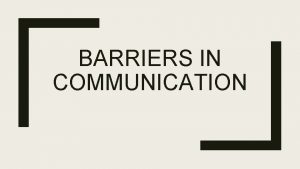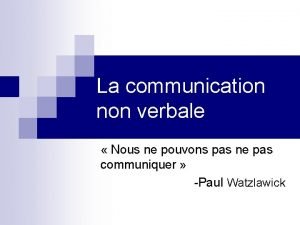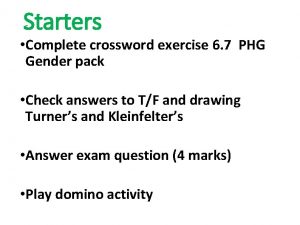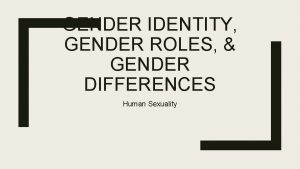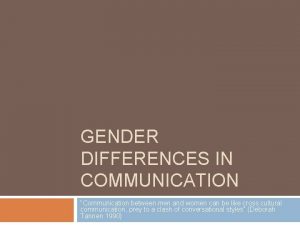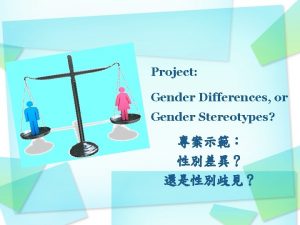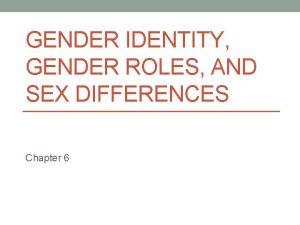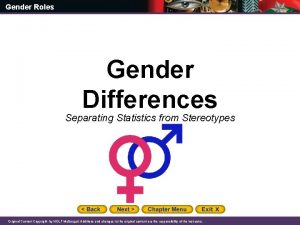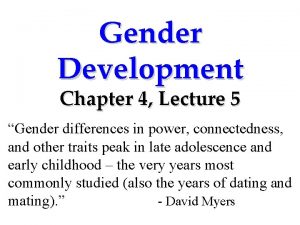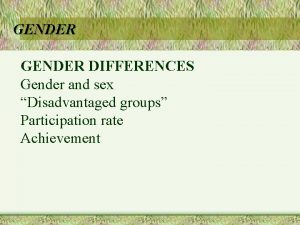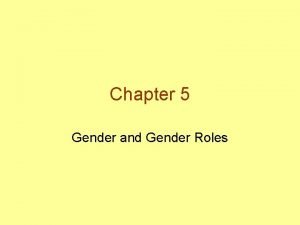Gender Differences in Communication Career Creators Consulting 1


























- Slides: 26

Gender Differences in Communication Career Creators Consulting 1

Gender Differences in Communication “Stereotypical Masculine & Feminine Styles and How to Effectively Use Both” Prepared by Amber Travis-Ballinas, MBA Career Consultant Career Creators 1250 Capital of Texas Hwy South Building 3, Suite 400 Austin, TX 78746 Office Phone: (512) 788 -2012 Careers@Career. Creators. Consulting www. careercreators. consulting Career Creators Consulting 2

What is Communication? = the process of exchanging ideas and information through words or actions. ****See Basic Interpersonal Communication Model Slide Career Creators Consulting 3

Communication the process of exchanging ideas and information through words or actions • Communication is the basis / fundamental building block of all human relationships. • The ability to communicate skillfully and with confidence will help each person develop supportive and cooperative work and personal relationships. • Improving interpersonal communication skills will improve all relationships; which ultimately improves chances of success. Career Creators Consulting 4

Reflective Listening & Communication • Good communication includes active / reflective listening – Allows both the listener and communicator / speaker to build trust and understanding – Allows the listener to be empathetic to the communicator / speaker – Saves time in the long-run – Short-term takes a lot of time & effort to do • Steps to Active / Reflective Listening: – Clarify the communicator’s point of view – Paraphrase understanding of the message – Do not “parrot” – Reflect core feelings back to communicator to signal understanding Career Creators Consulting 5

Types of Communication • • Verbal Communication = speaking Non-verbal Communication = all elements of communication that do not involve speaking or words – Written Communication = all written language including symbols – Technological Communication = interacting with a machine = lacking nonverbal cues Career Creators Consulting 6

Types of Communication • Verbal Communication = speaking – One-way Communication = no questions, feedback, or interactions occur Two-way Communication = both the communicator and receiver interact – • • Defensive Communication = communication that is aggressive, attacking, & angry OR passive, withdrawn, & submissive Non-defensive Communication = communication that is assertive, direct, & powerful without being defensive – Steps to Non-defensive Communication: » Define the situation » Clarify the communicator’s position (use active / reflective listening) » Acknowledge the communicator’s feelings (be empathetic) » Bring the focus back to the facts Career Creators Consulting 7

Types of Communication • Non-verbal Communication = all elements of communication that do not involve speaking or words – “Body Language” = • • • – – Perception of space and use of space Body Language / Facial Expressions / Eye Movements Pitch, cadence, volume, tempo, and tone of speech Written Communication = all written language including symbols Technological Communication = interacting with a machine = lacking nonverbal cues – Email – Text messaging – Voice messages / Voicemail – Fax – Internet Social Networking Sites Career Creators Consulting 8

Barriers to Communication • • • Language / Pronunciation / Diction Cultural Rules and Expectations Socialization of males and females Social Status / Educational Background Gender Method of communication (i. e. speaking versus writing) Noise / Distractions Incomplete communication Context of the communication (situation) Assumptions / Pre-conceived notions / Perceptual Screens • Personality / Personal Experiences Career Creators Consulting 9

Barriers to Communication Gender differences cause males and females to have very different perspectives which impacts why and how we communicate. This affects all aspects of communication. Career Creators Consulting 10

Stereotypical Differences in Masculine and Feminine Characteristics Masculine Traits: • • • • Feminine Traits: Self-serving attitude Direct use of power & authority Phrase directives as orders Task-oriented Need to be respected and admired Direct communication style Communicate to solve or fix problems Consciously tries to gain power & social status / ‘One-upmanship’ social hierarchy Expresses self-confidence willingly / okay to be boastful and proud of accomplishments Demands credit for accomplishments Less likely to ask questions in public or ask for help or directions Aggressive / dominant behavior Straight-forward and blunt communication Systematic rules Likely to attempt to win at all costs Negotiates specifically • • • • Concerned with other’s feelings Indirect use of power & authority Phrase directives as suggestions Relationship-oriented Need for acceptance and to be well-liked Indirect communication style Communicate to express feelings or to determine feelings and thoughts Consciously tries to keep relationships equal in power / Egalitarian social structure Does not express self-confidence willingly / reluctant to ‘brag’ or ‘toot their own horn’ Likely to give credit to others for their own accomplishments More likely to ask questions / for help / for assistance in public Nurturing / passive behavior Diplomatic / “beats around the bush” & ‘sugar-coats’ communication Free-flow rules / no rules Likely to play fair in negotiations Negotiates vaguely and considers the competitors’ pleas and feelings as part of the negotiation Career Creators Consulting 11

Why do we communicate? Women = • • to express feelings to ‘think out loud’ to determine feelings goal = want someone to listen and to understand their feelings Men = • • to communicate only the absolutely necessary information to solve problems and to “fix things” to give advice goal = want to communicate information and to solve problems Career Creators Consulting 12

How much do we communicate? Women = – speak approximately 3 times as many words per day as men = approximately 5000 words per day or more Men = – speak approximately one-third as many words per day as women = approximately 1700 words per day or less Career Creators Consulting 13

Communication Styles & Conversation Rituals Women = • • Men = Maintaining an appearance of equality Taking into consideration the impact of the interaction on the other person / people’s feelings and situation Downplaying their authority to get things done without having to be aggressive Being diplomatic and indirect Career Creators Consulting • Using playful opposition (joking, banter, teasing, etc. ) • Avoiding the “one-down” position in the interaction / maintaining their status on the hierarchy • Playing up their status / power / position of authority • Being blunt, direct, and straight-forward 14

Communication Styles & Conversation Rituals Problem & Solution for the Female Communicator Problem: – Solution: misunderstandings are caused by differences in style • • – blend both masculine and feminine traits Women may be viewed as less confident and competent than they really are Men may be viewed as hostile or arrogant when they really are not Career Creators Consulting • Be diplomatic AND direct and straight-forward. • Say what you mean—do not ‘beat around the bush’ or ‘sugar-coat’ communication • Use influence and legitimate power / authority to gain understanding and cooperation 15

Asking Questions in Public Asking for HELP Saying “I Don’t Know!” Women = • • Men = Willing to admit that they are not knowledgeable Not concerned about creating a negative impression More likely than men to ask questions in public Women who do ask questions in public are more focused on gaining information Career Creators Consulting • Less likely to admit that they are not knowledgeable • Admitting that they do not know / Asking for help puts them in a ‘one -down’ position and ruins their reputation • Men who do ask questions in public are more focused on the interaction and about positive impression management 16

Asking Questions in Public Problem & Solution for the Female Communicator Problem: – Women are not aware that they can be viewed as weak; asking questions can be viewed as negative and a sign of incompetence • • • Admitting ignorance or asking for help makes a person appear to be incompetent / creates a negative impression / causes a person to be judged as less capable Admitting ignorance or asking for help can prevent major problems and avert potential catastrophes Admitting ignorance or asking for help can mean that a person is searching for knowledge and information—this is positive. Solution: – Understand be aware of the negative perception that does exist. – Do your research and educate yourself, and then ask informed questions sparingly. – Clarify information on an as needed basis – Use reflective listening skills – Find a mentor or guide that you trust who can privately answer your questions and clarify information for you without judging you negatively. – ALWAYS ask for help whenever the wrong outcome might lead to disastrous consequences. Career Creators Consulting 17

Self-confidence--Are your SURE? Women = • • • Men = More likely to downplay their own certainty Being certain = being aggressive = being ‘un-lady -like’ Females modify their speech taking into account the impact they have on the other person’s feelings Self-confidence is viewed as a negative trait in females therefore women are reluctant to reveal the confidence that they do have. Women are reluctant to ‘toot their own horns’ or brag about their accomplishments Career Creators Consulting • More likely to downplay their own doubts • Being certain = being aggressive = being a ‘man’ • Self-confidence is a positive trait in males therefore men are likely to boast and exhibit self-confident behavior. • Men are likely to ‘toot their own horns’ and brag about their accomplishments and not be judged negatively for this behavior by society. 18

Self-confidence--Are your SURE? Problem & Solution for the Female Communicator Problem: Women and men are judged by different standards and there are different social expectations for each group. • • • Social constraints against women talking about their positive accomplishments are present in the USA. Social inhibitions against boasting can cause women to be viewed as less confident, therefore less competent. Women who do talk about their accomplishments are viewed as ‘over-confident’, ‘full-of-themselves’, etc. and judged negatively by society. Solution: – DO NOT be humble in your professional life!!!!!!!! – Be able to be comfortable sharing your accomplishments and successes with others. – Be able to ‘toot your own horn’ – Take credit for your work and do not allow others to take credit for or ‘steal’ your work or ideas – If you are certain that you are correct; state that you believe that you are correct and back it up with facts and information – Stay calm and unemotional Career Creators Consulting 19

Negotiation Styles / Competition Women = • More likely to be fair rather than try to win • ‘Beating’ the competition is not the main objective • Likely to begin vaguely and work her way into specifics • Likely to invite others to share their perspective • Likely to consider the competitors personal feelings and pleas and the impact that the conclusion will have on them Men = Career Creators Consulting • More likely to try to win or beat the competitor at all costs to avoid a ‘one-down’ position or damage to their reputation • Likely to begin specifically and negotiate out from there • Unlikely to invite others to share perspective; rather expect others to state their issues, ideas, etc. if they have any (part of the game) • Unlikely to consider the competitors feelings and pleas or the impact that the conclusion will have on them • Usually expect balanced negotiations / “give & take” or ‘tit for tat’--back and forth negotiations 20

Negotiation Styles / Competition Problems & Solutions for the Female Communicator Problem = Women and men have different expectations about how a negotiation is supposed to play out. • • • A negotiation begun vaguely may be viewed as a sign of weakness and an invitation for the competitor to take control A negotiation begun with a specific claim may be viewed as a nonnegotiable demand may end the negotiation process completely Many women do not understand that winning the negotiation is the goal. Solution = • Understand that men EXPECT you to negotiate. • Understand that many / most situations in life will require negotiation skills. • Be aware that a negotiation is to be played like a ‘game’ and the goal is to WIN the game! • Be prepared to negotiate. • Negotiate specifically, not vaguely, & allow for flexibility. • Be fair and kind but do not be taken advantage of for being kind and fair. • Try to create a ‘win-win’ for all. Career Creators Consulting 21

Leadership Women = • • • Men = Social constraints against females giving direction exist in the USA. Women who tell others what to do are called ‘bossy’ More likely to phrase ideas as ‘suggestions’ rather than directives More likely to explain directives in terms of the good they will do for the group overall More likely to be concerned with being liked by the group More likely to allow someone else to take credit for their accomplishments Career Creators Consulting • Social organization is hierarchical for men / someone is in the ‘one-up” position and someone is in the ‘one-down’ position on the ladder ALL OF THE TIME! • Men are expected to give directives and ‘boss’ the other lower-status members around • More likely to state their opinions strongly and create an impression of confidence • Less likely to be concerned about being ‘liked’; rather concerned about being ‘respected and admired’ • More likely to talk about their positive accomplishments and ‘toot their own horn’ / be sure they get credit 22

Leadership Problems & Solutions for the Female Communicator Problem = Society in the USA expects men and women to play by different rules. • Leaders are viewed as less competent and less self-assured when phrasing directives as ‘suggestions’ • Men are more likely to behave in ways that get them recognized as “leaders” in the workplace Solution = • Behave like a 24 / 7 professional and adopt traits typical of leaders – Be self-confident & certain – Be caring / empathetic / fair – Be charismatic • • • DO NOT phrase directives as suggestions—give directions / orders as needed State your opinions and back them up with facts and information. Be more concerned with being RESPECTED and less concerned with being POPULAR and LIKED by others. Career Creators Consulting 23

Summary • Historically, the workplace has had men in positions of authority and power. Therefore, male-style communication and interaction is the norm in most workplaces, even today. • Female-style communication and interaction are valid and relevant and have an important function in the workplace. However, when used as a singular communication style, it can be a disadvantage to women. • Women must recognize and understand that in order to be viewed as a competent, confident leader in the workplace; they must incorporate male-style communication skills into their everyday interpersonal communications. • If women adopted male-style communication skills and men adopted female-style communication skills; the workplace would likely be a much more productive and enjoyable environment. • Blend both masculine and feminine traits AND hold on to the uniquely feminine--stay true to what makes you a WOMAN! Career Creators Consulting 24

References • • • Organizational Development, Chapter 3: Communication. South-Western Thomson Learning Textbooks, 2000 “Active Listening” graduate research paper, James G. Clawson, Darden Graduate School of Business Foundation, University of Virgnia, Charlottesville, VA. , 1986 Talking 9 to 5, Deborah Tannen, Chapter One: “Women and Men Talking on the Job”, pgs. 143 -154 Men are from Mars, Women are from Venus, John Gray, Ph. D, Chapter One, Quill / Harper. Collins Publishers Games Mother Never Taught You, The Classic Guide to Making it in a Man’s World Corporate Gamesmanship for Women , by Betty Lehan Harragan. Mass Market Paperback, April 24, 1989 Career Creators “The Career Design Specialists” Career & Image Consulting Services www. Career. Design. Specialists. biz (512) 788 -2012 *All documents and workshop materials are confidential and/or legally privileged. You are hereby notified that any unauthorized review, use, disclosure, dissemination, distribution, or copying of any documents or workshop materials or any of their contents without written consent from the owner, is strictly prohibited. All documents, drafts, and workshop materials are protected by international copyright laws and are the sole property of “Career Creators”, “Career Design Specialists”, and “Woman is Beauty” and cannot be duplicated for any reason without express permission of the owner. Career Creators Consulting 25

Thank You! Prepared by Amber Travis-Ballinas, MBA Career Consultant Career Creators “The Career Design Specialists” Career & Image Consulting Services www. Career. Design. Specialists. biz 512 788 -2012 Career Creators Consulting 26
 Fall creators update whats new
Fall creators update whats new Uml creators
Uml creators Who are the three creators of money in the united states
Who are the three creators of money in the united states Creators spend as much time as possible in quadrant
Creators spend as much time as possible in quadrant John was busy yesterday evening
John was busy yesterday evening Strategic gender needs and practical gender needs
Strategic gender needs and practical gender needs 16 national career clusters framework
16 national career clusters framework Formulas for career success
Formulas for career success Gender interpersonal communication
Gender interpersonal communication Restrictive environment communication barriers
Restrictive environment communication barriers What is the study of communication, gender and culture
What is the study of communication, gender and culture Michel folco
Michel folco Punnett square xy
Punnett square xy Xxy gender
Xxy gender Gender action plan world bank
Gender action plan world bank Gender action plan world bank
Gender action plan world bank What is wid wad and gad
What is wid wad and gad Define gender parity
Define gender parity Deborah tannen difference theory
Deborah tannen difference theory The simple truth about the gender pay gap
The simple truth about the gender pay gap Define gender constancy
Define gender constancy Socialization is a lifelong process explain
Socialization is a lifelong process explain Doing gender definition
Doing gender definition Snow white different versions
Snow white different versions Xxy chromosome gender
Xxy chromosome gender Xxy chromosome gender
Xxy chromosome gender Gender-neutral housing pros and cons
Gender-neutral housing pros and cons









